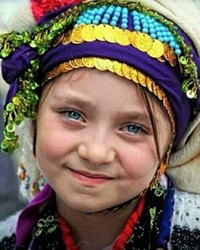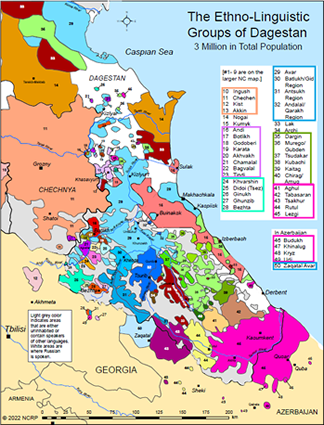The Rutul speak the Rutul language, which by classification which is nested within the Lezgi family of Dagestanian languages. Knowledge of Russian is widespread, and some of the older people also speak Azerbaijani. The Arabic script was used for their language until the 1930s. Today, the Rutul use Azerbaijani, Russian and Lezgi for written communication. The Rutul live in the Caucasus region of what is now southern Russia. They inhabit primarily the valleys of the Samur River and its tributaries in the southern part of Dagestan. The traditional territory of the Rutul lies between mountain ranges that are hard to cross, and it is marked by the gorges of torrential rivers. The winters are cold, and the summers are moderately cool with fog and rain. The mountain slopes are covered with grassy vegetation and are good summer pasture for livestock. Snow covers the upper part of the mountains year round.
Traditional Rutul settlements consisted of several quarters, each belonging to one tukhum, or clan. Each tukhum was composed of families who had descended from a common male ancestor. In the past, the center of the settlement was a mosque and a neighboring teahouse or clubhouse, where the men of one tukhum would gather. In the Soviet period, they built new settlements. Sometimes whole settlements were relocated to agricultural areas or to the Caspian plain. Today, a club or "house of culture" is located in the center of the settlement. Until the early 1900s, most Rutul lived in two-room, one- or two-storied stone houses. Instead of windows, the houses had light holes. Most modern buildings now have windows and are decorated with thick wool or felt carpets. Sheep and cattle production is the main occupation of the Rutul. Techniques for raising sheep have improved over the years, with better care administered during the long winter months. The herdsmen also grow spring and winter wheat, rye, barley, millet, and spelt (a hardy wheat). Traditional crafts include making pottery, leather footwear, and wool-based items such as cloth, felt, carpets, and ornamented socks. Their beautiful wool carpets and ornamented socks are produced commercially. The Rutul traditionally eat meat, dairy products and flour-based dishes. They eat meat fresh, dried and as sausages. They often preserve milk as butter and cottage cheese. Their diet is enriched with fruits, vegetables and herbs. At one time marriages were arranged by the parents, primarily the fathers. A matchmaker often mediated between the families. Choice of a groom was determined by the wealth of his family, the social status of his tukhum (clan), his diligence, and his health. Today, nuclear families are the norm, though some tukhums still existed in the early 1900s. Families are patriarchal (male dominated); women are fully subordinate to men. All of the family members are submitted to the male head of the household.
Islam became widespread among the Rutul during the tenth and eleventh centuries. Today, the Rutul are virtually all Muslim. Each settlement had a mosque and Muslim religious leaders. However, mingled with their Islamic practices were various ancient beliefs: a nature cult, hunting and fertility cults, animal worship, and occult rituals connected to family life and labor activities. They performed magic rites to summon sunshine or rain, and worshippers flocked to sacred groves, mountains, springs, tombs, and other sites connected with Muslim saints. Magical remedies were popular, including talismans (objects believed to confer supernatural powers or protection), "holy" water, earth from saints' tombs, and all kinds of invocations to false gods.
Most of the Rutul have not heard a clear presentation of the gospel. Disciple making efforts are active, and they need prayer.
Thank God that Scriptures are being translated into their language, and that the Rutul people will recognize the only Savior. Pray for spiritual openness to receive salvation by grace, and for this grace to spread throughout Rutul families and communities. Pray for the Lord to make a way for the gospel to move among the Rutul people. Pray for a Disciple Making Movement among the Rutuls, both in Russia and Azerbaijan.
Scripture Prayers for the Rutul in Russia.
| Profile Source: Joshua Project |
| Other PDF Profile |












